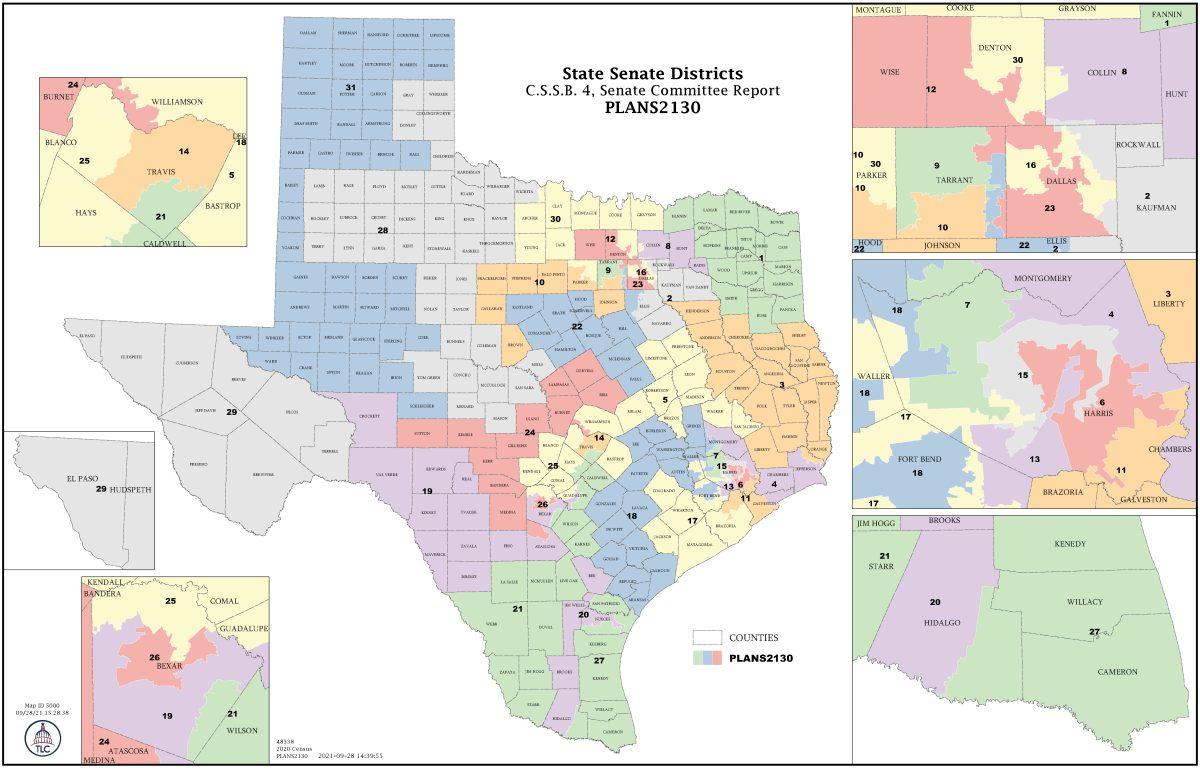As the United States becomes more racially diverse than ever before, political battles have begun over redistricting efforts at the local, state and federal levels.
On Monday, Sept. 27, the Texas State Legislature released the first drafts of new congressional and State Board of Education maps that could guide state politics for the next decade. Texas will be the only state in the union to gain two congressional seats, for a total of 38, the U.S. Census Bureau announced in April. The legislature does not gather the data for redistricting directly, however, as they oversee the process carried out by Texas county commissioners. Brazos County’s Commissioners kicked off their process in a special workshop session on Tuesday, Sept. 28.
Bickerstaff Heath Delgado Acosta LLP, an Austin-based law firm, is overseeing redistricting for Brazos County, elections administrator Trudy Hancock said. The Census Bureau reported the county’s population to be 233,849, seeing a growth of 17.6 percent since 2010, according to the Bureau’s QuickFacts website.
“[The firm will] get information that is down to the granular level, such as how many warm bodies there are per house,” Hancock said. “They divide the county into census blocks, and that block information will be used to determine how many people are in a voting precinct.”
The county code requires the commissioner districts to be aligned within a 5 percent error of having the same number of voters, in order to ensure voters are represented equally between the four commissioners, Hancock said. On a smaller scale, the voting precincts for Election Day must not exceed 5,000 people. Fortunately, elections administrators will not need to accommodate any increases in elected offices, Hancock said.
“As much growth as Brazos County is seeing, we need to be sure that we accommodate growth over the next ten years,” Hancock said.
Hancock, who oversaw the 2010 redistricting process for another county, said the process has been severely delayed by COVID-19.
“We should have received them early 2021,” Hancock said. “Normally, by about March or April or so it’ll get down to the county level who will then receive that information. It will probably cause a delay in the primaries, they probably will not be in March.”
Now in the hands of administrators across the country, the census data results suggest that the United States is more racially and ethnically diverse than ever before, potentially seeing a decrease in the white share of the population. In an email to The Battalion, a representative of the Census Bureau, who preferred to remain anonymous, said the interpretation of these changes is complicated due to how race is reported.
“The U.S. Census Bureau collects race data in accordance with guidelines provided by the U.S. Office of Management and Budget, or OMB, and these data are based on self-identification,” the Bureau spokesperson said in the email. “The racial categories included in the census questionnaire generally reflect a social definition of race recognized in this country and not an attempt to define race biologically, anthropologically or genetically.”
Since the questionnaire’s categories reflect social definitions, a person can self-identify as “White alone,” or “White in combination,” such as “White” and “American Indian,” the Bureau spokesperson said. Although the “White alone” population decreased by 8.6 percent since 2010, the “White in combination” population saw a 316 percent increase during the same period, according to the Bureau’s Frequently Asked Questions About Race and Ethnicity.
In light of the discrepancies in how race is defined and new voting maps at the state level, some representatives and advocates have voiced concerns that the drafts are already discriminatory, according to the Texas Tribune. Texas Sen. Beverly Powell’s District 10 is currently contained entirely within Tarrant County, which saw 53 percent of voters go to President Joe Biden in 2020 and a dramatic increase in minority voters, according to a statement by Powell. The new map would place District 10 in the more conservative Parker and Johnson counties.
“Over the years, when people have had the opportunity to vote and lots of change resulted, we saw more efforts made to imbalance the opportunities that many people of color, in particular, had to represent themselves as well as their interests,” director of the Race and Ethnic Studies Institute at Texas A&M Troy Harden said. “And much of that discrimination has been racialized and have been efforts by politicians, mostly white, who have sought efforts to maintain control of the voting process.”
Harden, a professor of sociology, said as recently as the 2010 redistricting, the U.S. Supreme Court declared district maps unconstitutional in Texas. Despite people of color making up 95 percent of Texas’ population growth, according to the 2020 census results, the new draft reduces the number of districts in which they are the majority of eligible voters.
“I think there are two things [the census result] says. One is, ‘What a great and rich and diverse and interesting country we have.’ That if anything history has shown us [is] that our diversity enhances our democracy and who we are. So there’s an exciting opportunity within that,” Harden said. “The flip is that it’s growing a lot of anxiety and concern within the previously-predominant white population, [some of whom] are now concerned about losing voice and/or power. I think those tensions between that opportunity and the anxiety about the opportunities will mean some challenges in terms of political conflict for the future.”
At the Race and Ethnic Studies Institute, Harden said the goal is to support research and researchers who study topics like gerrymandering, and how such policies impact education, health, housing and rights. Knowing that minority populations are only growing in Texas, Harden said the Institute wants to prompt discussions of the changing dynamics, as well as how to build an equitable and just society.
“There are often sophisticated ways that people will advance their efforts to maintain control,” Harden said. “Which means that there has to be greater advocacy on both the federal and the state level to really be able to make sure that a policy, and similar decisions, are equitable and fair, and supportive of our democracy.”
Battle lines drawn over state redistricting
September 30, 2021
0
Donate to The Battalion
$2790
$5000
Contributed
Our Goal
Your donation will support the student journalists of Texas A&M University - College Station. Your contribution will allow us to purchase equipment and cover our annual website hosting costs, in addition to paying freelance staffers for their work, travel costs for coverage and more!
More to Discover










